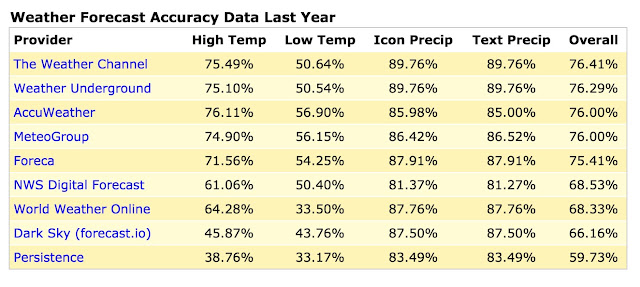Cliff Mass of the University of Washington posted a very interesting blog on who provides the most accurate weather forecasts. While the results are for locations in the state of Washington, they likely reflect other areas as well. It does appear private forecasts such as from The Weather Channel and AccuWeather are as good or better than the National Weather Service in providing information on daily temperatures and chances of precipitation. When it comes to forecasting severe storms it is noted that the Storm Prediction Center is world-class.
Who provides the best weather forecasts?
One question I frequently get is: where can I get the best weather forecasts? Quality varies substantially and the answer is often different between garden variety forecasts and more difficult rare/severe weather events.
So what about garden-variety weather predictions? What source is best? The National Weather Service, Weather.com or Accuweather? Or what?
There is a web site, forecastadvisor.com, that provides average verification statistics for the last month or year for a large number of locations. Our independent verification for some Northwest locations suggests that this site is relatively reliable.
Here is the table for Seattle for the last year. For temperature, they consider a forecast accurate if it is within 3F. Precipitation is not so clear, since they consider the forecast as rain if there is any chance of precipitation in the forecast. So you might dismiss the precipitation evaluation...although all forecasts are verified in the same way.
Considering temperature, the three best are the Weather Channel, the Weather Underground, and Accuweather--I doubt whether the differences are statistically significant. The Weather Service is a step down.
What about Spokane? The same three are on top, but this time Accuweather is the leader, particularly for low temperatures. They are good at low temperatures. Again, the NWS lags a bit.
Finally, lets look at Yakima, the primary agricultural center of our state. Same three in the lead, and Accuweather is again better at the low temperatures.
So why do the Weather Channel, Weatther Underground and Accuweather produce better forecasts than the National Weather Service on average? The key reason is that they generally make use of multiple weather forecast models (e.g., US GFS, European Center and UK Met Office models), and then do sophisticated sophisticated statistical postprocessing to combine the forecasts in an optimal way. The National Weather Service has lagged in statistical postprocessing, depending heavily on a forty-year old system called MOS, Model Output Statistics. Thus, it the guidance provided to National Weather Service forecasts has been less than state of the art.
Fortunately, this is changing. During the past year, the NWS has developed the National Blend of Global Models, which statistically combines an international collection of global models and traditional MOS to produce better forecasts. The results so far are encouraging, with reduced error and lower biases.
With these advances, I would expect the National Weather Service average statistics will move closer to the Weather.coms and Accuweathers during the next year.
The National Weather Service human forecasters do play an important forecasting role, particularly when unusual and extreme weather occurs. Events in which the models and statistics can fail, but where long experience and physical insights can be critical. Some private firms, like Accuweather, have also invested heavily in a substantial human forecaster contingent.
The National Weather Service forecasters are positioned in a two-tiered system: the roughly 120 forecasts offices spread around the nation, and national speciality centers, such as the the Storm Prediction Center in Norman Oklahoma or the Weather Prediction Center in Washington DC. The first group is responsible for local prediction, while the latter specializes in specific types of extreme events, like severe convection (Storm Prediction Center) and heavy precipitation/flooding (Weather Prediction Center).
The Weather Prediction Center has found that humans can provide positive impacts for very heavy precipitation events over numerical model guidance (of course the humans START with the numerical guidance). The Storm Prediction Center is absolutely world class, providing the best severe thunderstorm warnings in the world.
The future will be one where garden variety weather is mainly taken care of by statistically corrected ensembles of models, with humans spending most of their time dealing with extreme weather, resolving with model problems, and communicating forecasts to the public and critical user communities.
Even today if you are looking for a weather forecast on average day, the forecast from your typical weather app (weather.com, accuweather, etc.) are fine. But when severe weather is possible, turning to an outlet in which humans are carefully following the situation is advised.





No comments:
Post a Comment